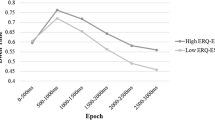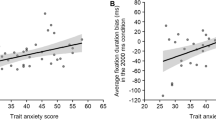Abstract
This study investigated the relationship between stressful arousal and conjugate lateral eye movement tendencies in right-handed males. Sixty subjects were asked both neutral and mildly emotional questions after watching either a stressful industrial accident movie or a bland control film. Subjects had been previously classified as either right-movers, left-movers, or bidirectionals on the basis of their responses in a prefilm interview. A statistically significant interaction between dominant direction and film condition was found on right eye movement. Subjects classified as right-movers displayed increased right eye movement preferences under the stress film, compared to the neutral film condition. This effect was seen with neutral, but not mildly emotional, questions. Results were interpreted within an elaborated brain asymmetry model of conjugate lateral eye movement, in which stressful arousal is assumed to increase subjects' reliance on characteristic, neurologically based ways of dealing with stimuli. Implications for theory and research on brain-behavior relationships in ego-defensive styles are discussed.
Similar content being viewed by others
References
Bakan, P. Hypnotizability, laterality of eye movements and functional brain asymmetry.Perceptual and Motor Skills 1969,28 927–932.
Bakan, P. The eyes have it.Psychology Today 1971,4 64–69.
Gleser, G. C., & Ihilevich, D. An objective instrument for measuring defense mechanisms.Journal of Consulting and Clinical Psychology 1969,33 51–60.
Gur, R. E. Conjugate lateral eye movements as an index of hemispheric activation.Journal of Personality and Social Psychology 1975,31 751–757.
Gur, R. E., & Gur, R. C. Defense mechanisms, psychosomatic symptomatology, and conjugate lateral eye movements.Journal of Consulting and Clinical Psychology 1975,43 416–420.
Gur, R. E., & Reyher, J. The relationships between style of hypnotic induction and direction of lateral eye movement.Journal of Abnormal Psychology 1973,82 499–505.
Lazarus, R. S., Opton, E. M., Nomikos, M. S., & Rankin, N. O. The principle of short-circuiting of threat: Further evidence.Journal of Personality 1965,33 622–635.
Meskin, B. B., & Singer, J. L. Daydreaming, reflective thought, and laterality of eye movements.Journal of Personality and Social Psychology 1974,30 64–71.
Schwartz, G. E., Davidson, R. J., & Maer, F. Right hemisphere lateralization for emotion in the human brain: Interaction with cognition.Science 1975,190 286–288.
Woods, D. J. The repression-sensitization variable and self-reported emotional arousal: Effects of stress and instructional set.Journal of Consulting and Clinical Psychology 1977,45 173–183.
Woods, D. J., & Patten, T. G. Repression-sensitization and non-verbal expressiveness.Journal of Personality Assessment, in press.
Woods, D. J., & Steigman, K. B. Conjugate lateral eye movement and interpersonal arousal: Effects of interviewer sex and topic intimacy.Personality and Social Psychology Bulletin 1978,4 151–154.
Zuckerman, M., & Lubin, B.Manual for the Multiple Affect Adjective Check List. San Diego: Educational and Industrial Testing Service, 1965.
Author information
Authors and Affiliations
Rights and permissions
About this article
Cite this article
Woods, D.J., Beecher, G.P. & Ris, M.D. The effects of stressful arousal on conjugate lateral eye movement. Motiv Emot 2, 345–353 (1978). https://doi.org/10.1007/BF00993329
Issue Date:
DOI: https://doi.org/10.1007/BF00993329




